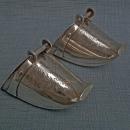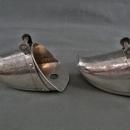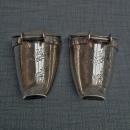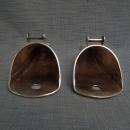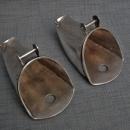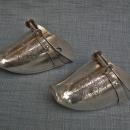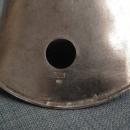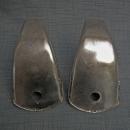Antique South American Silver Plated Children’s Stirrups in Spanish Colonial Conquistador Manner








$400.00
Or Best OfferA pair of antique Brazilian parade children’s stirrups from the beginning of the 20th century, silver plated on copper in the Spanish colonial conquistador manner in the form of slippers. This shape protects the rider's feet from injury. Each stirrup is made of separate elements joined together, including soles; the top part is finely hand engraved with an ornate floral pattern and fitted with a riveted band rising to the sturdy loop for suspension. Sometimes, people call them "wall pocket stirrups" because there is a circular hole in the sole of each stirrup for drainage, which they use for hanging on a wall.
Each stirrup is marked 323 and AE in an oval.
CONDITION: They show age and usage. One of the stirrups for the right leg shows some wear on the inside, most likely from driving the horse with the right leg. Also, there are minor abrasions on this stirrup's sole.
Please see the pictures in the listing since they are part of the object's condition.
DIMENSIONS: (Approximately) Length: 17.5 cm (6.89 inches). Width: 9.8 cm (3.86 inches). Height: 10 cm (3.94 inches).
WEIGHT: 579 grams
The History of Stirrups: In most civilizations, the horse was used more in chariots than for riding until about 800 BC. Before stirrups, most equestrian cultures used no support for the feet. There are records of a loose surcingle being employed behind the girth, into which the feet could be tucked. Toe stirrups (loops of rope that held the big toe) were first recorded in Northern India in the 2nd century BC, and their use was limited by climate and footwear. The first stirrups designed to take the entire foot were single-mounting stirrups recorded in China in the 4th century AD. The mounting stirrup was easier than using a stool to mount and safer than vaulting on when fully armed (Cambyses, king of Persia, stabbed himself while mounting when fully armed in 522 BC – AD H. “The Stirrup and Its Origins.” Oriental Arts, n.s. 1 (1955): 61-68.). Paired stirrups were first recorded in the 4th Century AD on a Chinese pottery horse, and a stirrup was found in a 4th Century Chinese grave.
Their use spread through Central Asia and Europe by the 8th century AD. The stirrup revolutionized riding and warfare. It allowed the cavalry to ride further and faster. Heavy cavalry and the use of lances developed, as did light cavalry and mounted archers. Some elements like the saddle, stirrups, spurs, bits, and bridles became popular in Byzantine times, and their use spread throughout Europe. This stirrup style evolved in Europe during the days of Knights & Cavaliers. The use of these devices helped the rider achieve greater stability and mount and dismount the horse with relative ease. This fact was especially crucial when the rider was wearing heavy armor in which the weight of the metal would be enough to topple him off the horse. The use of enclosed stirrups served the purpose of providing a firm, solid base platform for the Horseman to stand up while wielding his sword, charging with a lance, or shooting arrows, also providing armor to the feet of the rider. It has been said that the Spanish Conquistadors brought this type of stirrup to the New World as part of their horse equipment. Others state that these stirrups were produced in the ‘New World’ after the Conquistador arrived.
These types of ornate silver-plated stirrups were made for wealthy landowners and their family members as parade stirrups used for special occasions such as holidays, weddings, church trips, and other important occasions.
